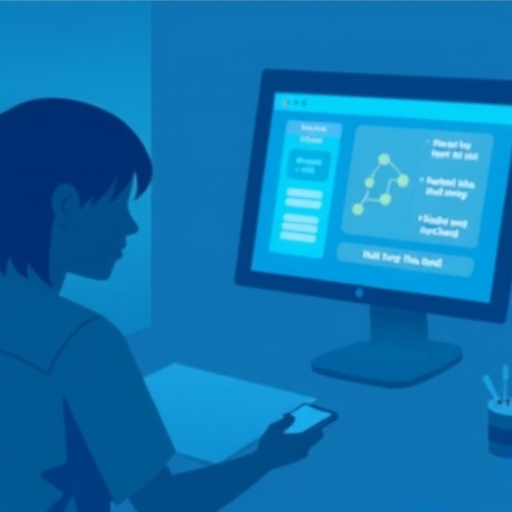In a groundbreaking advancement poised to reshape our understanding of the brain’s reward circuitry, researchers have demonstrated that non-invasive ultrasonic stimulation targeting the human nucleus accumbens can significantly modulate reward sensitivity. This pioneering study, recently published in Nature Communications, offers compelling evidence that focused ultrasound neuromodulation can influence complex human behavior related to reward processing without the need for invasive procedures. Such a technological leap opens new avenues not only for neuroscience research but also for potential therapeutic interventions in psychiatric disorders where reward dysfunction plays a critical role.
At the heart of this investigation is the nucleus accumbens, a small but profoundly influential structure located deep within the ventral striatum. This region is widely recognized as a central node in the brain’s reward network, involved in reinforcing behaviors, processing pleasurable stimuli, and integrating motivational states. Dysregulation of the nucleus accumbens has been implicated in conditions ranging from addiction to depression, mood disorders, and even schizophrenia. Yet, until now, modulating this hard-to-reach nucleus without surgery has posed considerable challenges.
The team led by Yaakub, S.N., Eraifej, J., Bault, N., and colleagues deployed an innovative ultrasonic neuromodulation strategy to target the nucleus accumbens non-invasively. By applying precisely calibrated ultrasonic waves to the region, they could alter neuronal excitability and activity patterns associated with reward sensitivity. Unlike traditional electrical stimulation methods that require implants or invasive procedures, ultrasonic neuromodulation offers a non-destructive, highly focal, and reversible approach, allowing for the modulation of deeply situated brain structures with exquisite specificity.
The methodology behind this technique involves the use of low-intensity focused ultrasound (LIFU). This modality enables ultrasound beams to be directed through the intact skull with millimeter precision. Ultrasonic energy induces mechanical effects at the cellular level that can modify ion channel activity and neural membrane dynamics, which subsequently changes neuronal firing rates. The researchers carefully optimized ultrasound parameters such as frequency, pulse duration, and intensity to ensure safety while achieving effective neuromodulation.
Subsequent to stimulation, participants exhibited measurable shifts in their reward sensitivity, as evaluated through psychometric assessments designed to quantify behavioral and cognitive responses to reward-related tasks. These changes suggest that ultrasonic neuromodulation of the nucleus accumbens not only influences neural activity but has tangible effects on how individuals perceive and respond to rewards. Such findings hold immense promise for addressing neuropsychiatric disorders marked by impaired reward processing.
Critically, the study also monitored off-target effects and safety outcomes. No adverse events or cognitive deficits were observed, underscoring the technique’s potential as a safe and well-tolerated neuromodulation tool. The ultrasonically induced modifications were transient and reversible, indicating that the brain’s natural activity patterns returned to baseline following cessation of stimulation. This reversibility is vital for clinical applicability and for designing interventions tailored to individual therapeutic windows.
Importantly, this research addresses a significant limitation that has stymied progress in neuromodulation: accessibility to deep brain structures without invasive means. Conventional methods such as deep brain stimulation (DBS) require surgical implantation and carry risks of infection, hemorrhage, and long-term hardware complications. In contrast, ultrasonic neuromodulation circumvents these risks by offering external application with non-ionizing radiation, expanding the potential patient pool and increasing acceptance for experimental therapies.
The implications of modulating the nucleus accumbens extend beyond clinical therapies to fundamental neuroscience. This technique allows for controlled experimentation on humans to better dissect the causal relationships between neural circuit activity and complex behaviors linked to reward, motivation, and decision-making. By fine-tuning neural excitability with ultrasonic pulses, researchers can study neural plasticity and adaptability in vivo, providing richer insight into the dynamics underpinning human cognition.
Looking ahead, the versatility of focused ultrasound neuromodulation could be harnessed to develop personalized treatment paradigms. Disorders such as substance use disorder, major depressive disorder, bipolar disorder, and obsessive-compulsive disorder, which share reward circuitry anomalies, could benefit from targeted neuromodulatory therapies. Non-invasive modulation might complement or even replace pharmacological interventions, reducing systemic side effects and enhancing treatment precision based on individual neural profile mapping.
Additionally, the combination of functional neuroimaging with ultrasonic stimulation—incorporating dynamic brain mapping tools like fMRI or PET scans—could yield real-time feedback on neuromodulation effects. This integrative approach would enable optimized dose-response titration and adaptive stimulation protocols, further improving efficacy while minimizing unintended consequences. Such closed-loop systems represent the future frontier of neuromodulation.
The study’s authors also highlighted potential constraints and directions for continued exploration. While the modulation of reward sensitivity was clear, the underlying molecular and electrophysiological mechanisms remain to be fully elucidated. Future investigations might delve deeper into synaptic and network-level changes induced by ultrasound. Longitudinal studies assessing the durability of behavioral effects and the potential for neuroplastic adaptation over repeated sessions are essential for translating findings to clinical practice.
Beyond neurology and psychiatry, the technology could have broader implications in cognitive enhancement, rehabilitation, and brain-machine interfaces. By fine-tuning motivation and reward responsiveness, ultrasonic neuromodulation might improve outcomes in learning disorders, post-stroke recovery, and even augment human performance in healthy individuals. Ethical frameworks and regulatory guidelines will be crucial to navigate the potential challenges posed by manipulation of complex human behaviors.
In summary, this landmark study confirms that non-invasive ultrasonic neuromodulation targeting the nucleus accumbens distinctly alters human reward sensitivity, ushering in a new era of precision brain stimulation. It demonstrates the capability to manipulate deep brain circuits through a non-invasive, focal, and reversible approach, potentially transforming our approach to neuropsychiatric disorders and advancing neuroscience research on the neural basis of reward. As research continues to refine and expand this technique’s applications, the prospect of harnessing ultrasound waves to orchestrate brain function with unprecedented finesse becomes a tangible reality.
The rapid evolution of focused ultrasound technology paired with sophisticated brain mapping and computational modeling is catalyzing breakthroughs in neuromodulation previously thought unattainable. This research decisively shifts the paradigm, illustrating that safe and effective modulation of the human brain’s most guarded territories is possible without scalpels or implants. It epitomizes the convergence of biophysics, engineering, and cognitive neuroscience toward innovative solutions tackling some of the most daunting challenges in mental health and brain science.
As more clinical trials and translational studies are initiated based on this proof of principle, public interest and scientific enthusiasm for ultrasonic neuromodulation will undoubtedly grow. This modality’s non-invasive nature and promising early results could make it one of the most impactful neurotechnologies of the decade. The ability to directly modulate the human brain’s reward system with ultrasound heralds transformative potential spanning medical, psychological, and societal domains.
This exciting breakthrough invites further collaboration across disciplines to maximize therapeutic, cognitive, and ethical outcomes. The researchers’ work underscores the power of technology to unlock the mysteries of the mind and restore function where disorders have long confounded treatment. Ultimately, non-invasive ultrasonic neuromodulation may emerge as the quintessential tool to fine-tune brain circuits underlying motivation, emotion, and behavior, creating new hope for millions worldwide.
Subject of Research: Non-invasive ultrasonic neuromodulation of the human nucleus accumbens and its effects on reward sensitivity
Article Title: Non-invasive ultrasonic neuromodulation of the human nucleus accumbens impacts reward sensitivity
Article References:
Yaakub, S.N., Eraifej, J., Bault, N. et al. Non-invasive ultrasonic neuromodulation of the human nucleus accumbens impacts reward sensitivity. Nat Commun 16, 10192 (2025). https://doi.org/10.1038/s41467-025-65080-9
Image Credits: AI Generated
DOI: https://doi.org/10.1038/s41467-025-65080-9
Tags: addiction and reward circuitryhuman reward sensitivitymodulation of complex behaviorneuroscience research advancementsnon-invasive brain stimulationnucleus accumbens stimulationpsychiatric disorder interventionsreward processing in humanstherapeutic applications of ultrasoundultrasonic neuromodulationultrasound technology in mental healthventral striatum function





